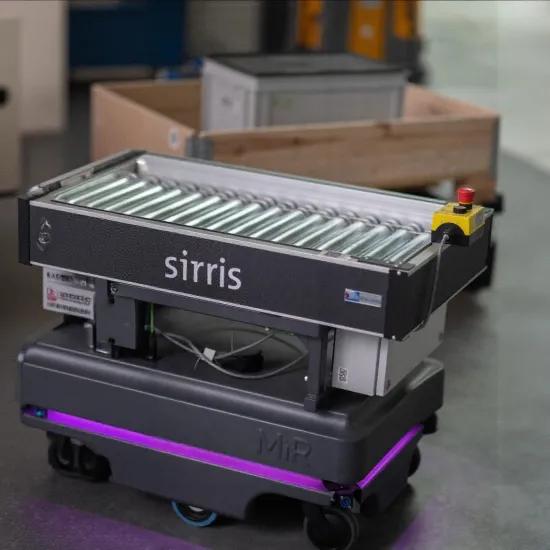While AGVs and AMRs can bring significant benefits in terms of efficiency and productivity, they also introduce new safety risks that must be addressed. In a series of blogs, we will explore AGV safety from multiple angles. In this second blog post of our series, we will delve into the safety assessment process for AGV and AMR systems.
Automated guided vehicles (AGVs) and autonomous mobile robots (AMRs) are becoming increasingly common in manufacturing, warehousing, and logistics operations. While these vehicles can bring significant benefits in terms of efficiency and productivity, they also introduce new safety risks that must be addressed. In a series of blogs, we have been exploring AGV safety from multiple angles, including the legislative framework that governs it, the road toward safety in terms of best practices, and the stakeholders involved and their respective responsibilities. Our comprehensive exploration of AGV safety will provide valuable insights into the challenges and opportunities associated with this rapidly developing field.
Safety assessment process
In our previous blog post, we explored the legislative framework that governs the safety of automated guided vehicles (AGVs) and the importance of regulatory compliance. However, regulatory compliance alone cannot guarantee the complete safety of AGV systems. To ensure safety, it is necessary to conduct a thorough safety assessment of the AGV system and its environment.
In this second blog post we will delve into the safety assessment process for AGV systems, including the different types of safety assessments, the factors that should be considered, and the best practices for conducting a comprehensive safety assessment. By understanding the safety assessment process, organizations can identify potential hazards and mitigate risks, ultimately enhancing the safety and efficiency of their AGV systems.
Manufacturer's mandates
The Machinery Directive regulates the activities of machine manufacturers, distributors, and safety component suppliers. It specifies the essential responsibilities that manufacturers must meet to ensure new machines comply with minimum health and safety standards, thereby safeguarding users and operators. A key requirement for manufacturers is to build machines that are inherently safe, which involves redesigning or reconstructing potentially hazardous components to eliminate the need for additional safety measures. Throughout the design and manufacturing stages, manufacturers must thoroughly identify and evaluate all potential hazards and risks through a comprehensive risk assessment process.
The graphic below illustrates the phases that must be taken into account when implementing risk reduction measures for the AGV/AMR vehicle.
In the safety assessment process, hazard analysis and risk estimation are typically the first steps. A risk assessment involves a logical process of identifying and examining potential hazards related to personnel and load handling. This information is then used for a risk evaluation, in which a decision is made on the safety of the vehicle and any necessary risk reduction measures. To aid in this process, the ISO 3691-4 standard includes Annex B, which contains a table outlining the seven types of hazards (Mechanical, Electrical, Thermal, Material/Substance, Ergonomic, Environment in which Industrial Truck is used, and Combination of hazards) and their possible consequences and safety requirements. Below is an abstract on Mechanical Hazards, which is one of the hazard types listed in the table.
In the second step of the safety assessment, safety requirements are chosen based on the identified hazards and their consequences. Clause 4 of the standard lists the necessary safety requirements and protective/risk reduction measures. This section provides detailed information on electrical requirements, referencing both EN 1175 (Electrical requirement for trucks) and IEC 60204-1 (Electrical safety of machinery) standards, as well as other current standards for protective equipment, such as guards (ISO 14120:2015), interlocking devices (ISO 14119:2013), and electro-sensitive protective devices (IEC 61496-2:2013 & IEC 61496-3:2018). Additionally, the standard considers hydraulic (ISO 4413:2010) and pneumatic (ISO 4414:2010) fluid power and covers other aspects such as the braking system, speed control, emergency stop circuit, and mode selection. Normal climatic conditions are also taken into account in this section.
To ensure the overall safety of an AGV, it is crucial to consider the relationship between different protective functions and safety measures during the design process. The AGV/AMR control system plays a crucial role in controlling the speed, stability, load, and steering of the vehicle. However, some of its functions, such as the personnel detection system, rely on the proper functioning of other safety measures, including the braking system. ISO 3691-4 outlines various safety requirements and protective measures that must be taken into account, such as the braking system, speed control, emergency stop circuit, mode selection, and compliance with standards for protective equipment like guards and interlocking devices. It is important to have a comprehensive understanding of these requirements and their interdependence to ensure the overall safety of the AGV system. The provided diagram illustrates the relationship between different safety measures as stated by ISO 3691-4.
The third step is to define the minimum level of performance for all specified safety functions in relation to the control system.
The minimum performance level required for each safety function of a machine to reduce risk to an acceptable level is referred to as the required performance level (PLr). To define the appropriate safety performance level, the mass and energy of the machine are taken into account. For instance, a truck carrying a heavy load at high speed requires a higher PLr than a light truck traveling at a slow speed. The PLr value for safety functions on each vehicle may vary depending on the mobile platform type and application.
It is essential to understand the safety performance level as a "safety chain" where the strength is equivalent to its weakest link. If a safety function for an AGV requires a minimum PLr d, then all safety-related parts of the control system, such as safety laser scanners, safety PLC, encoders, bumpers, etc., must be capable of achieving or exceeding PL d.
ISO 3691-4 stipulates that safety-related parts of the control system shall comply at least with the performance levels listed in Table 1, section 4.11. Table 1 provides an excerpt with two safety functions related to the braking system. Based on the associated risks, a specific PL is required according to ISO 13849-1. Safety Function number 1 ('Braking System') requires a PLr d, and Safety Function number 2 ('Parking Braking System') requires a PLr b.
The fourth step aims to ensure that the implemented measures effectively reduce security risks to the desired level. This validation process usually involves various activities such as visually inspecting the AGV, conducting functional tests to evaluate the efficacy of safety measures, re-evaluating risks after implementing the measures, and reviewing documentation. To verify compliance with health and safety requirements, Clause 5 and Annex E of the standard shall be followed.
In accordance with ISO 12100, providing information for use is a critical aspect of designing a driverless truck system. The information for use must be provided under three main areas: signals and warning devices, marking, warning signs, and information plates, and accompanying documents such as the instruction handbook for use and instructions for putting the system into service. The latter should include information on commissioning methods, technical details, special training requirements, and recommendations for floor/ground marking during commissioning and permanent marking at handover. Compliance with ISO 3691-4 Clause 6 must be verified to ensure that all information for use requirements have been met.
Safety of AGV application in specific environment
Employer's obligations
The Work Equipment Directive 2009/104/EEC outlines the responsibilities of employers regarding the use of machinery and equipment in the workplace. Since machinery may present new hazards when installed at their intended locations, employers are required to carry out a thorough risk assessment in their operational settings, taking into account the installation requirements and the surrounding environment.
So far, we have discussed the risk reduction measures related to the AGV vehicle itself, but what about the safety of the entire AGV application, particularly when it is installed in a specific environment? It is not possible for the AGV manufacturer to account for all safety requirements, and therefore, it is essential for AGV integrators to adhere to certain best practices during installation. To ensure overall safety, a subsequent risk assessment must be conducted and agreed upon between the integrator and user for each AGV application. For this purpose, ISO 3691-4 Annex A provides a classification of four types of AGV operation zones based on safety system conditions: operating zones, operating hazard zones, restricted zones, and confined zones. The classification in zones depend on the clearance between the contour of the AGV (or its load) and the nearest fixed structure and the presence of an active safety-related detection device in the travel direction.
An 'Operating Zone' is defined as having a minimum clearance of 0.5 m wide for a height of 2.1 m on both sides of the AGV path, and an effective personnel detection system in place. The other three zones are classified as areas of increased risk of a person being exposed to a hazard.
Annex A specifies the preparations required to eliminate hazards for each type of zone, including markings, guards, interlocking systems, escape routes, and more. The user and system integrator must designate hazard and/or restricted zones as such during the design, installation, and start-up phases, and ensure they are continually and clearly marked with floor/ground markings, lights, or other designations after installation.
Other important safety considerations for the entire AGV system include taking appropriate safety measures at the workplace (such as protection efficiency, danger spots, and load handling), ensuring that associated equipment such as conveyors are well CE marked, defining safe operation rules and training operators accordingly, implementing AGV mobility and control measures, using warning signage and systems, defining modes of operation for the AGV, designing loading/unloading areas, implementing emergency stopping measures, controlling access, implementing authorized starting procedures, assessing residual risks, and providing personal protective equipment (PPE).
To conclude this second blog post, we have explored the safety assessment process for AGV systems and emphasized the importance of conducting a comprehensive safety assessment. Through the safety assessment process, organizations can identify potential hazards and mitigate risks, ultimately enhancing the safety and efficiency of their AGV systems. It is crucial to consider various factors in the safety assessment process, including the system's environment, design, and operational use. By taking a proactive approach to safety, organizations can minimize the potential for accidents and injuries and ensure regulatory compliance.
In the upcoming and last blog post in this series, we will provide a brief overview of the responsibilities of each stakeholder involved in ensuring the safety of AGV systems, including the manufacturer, integrator, and end-user.
As a company, how can you assess how to sensibly deploy AGVs or AMRs, and what are the steps involved in such a process? Contact us!
This blog post has been published in the context of the Standards Cell Industry 4.0 and the FlexIn²Log project, which aims to support manufacturing companies and their logistics and ICT partners to use digital technologies and platforms, and digitally driven AMRs, to increase the flexibility and efficiency of inbound and internal logistics.










